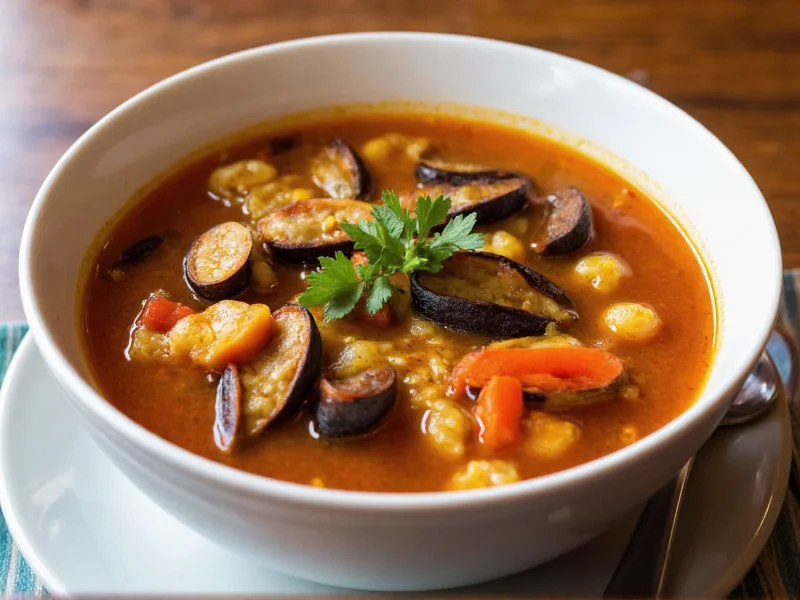Eel soup represents one of the world's most enduring aquatic culinary traditions, with preparation methods refined over centuries across different continents. This distinctive broth transforms humble freshwater or saltwater eels into a nourishing meal celebrated for both its delicate flavor and nutritional profile. Unlike many seafood soups, properly prepared eel soup features meat that's remarkably tender with a subtle sweetness that absorbs surrounding flavors while maintaining its unique character.
Cultural Significance Across Continents
The preparation of eel soup reveals fascinating cultural adaptations. In Japan, unajyu and unadon feature eel simmered in a sweet-savory tare sauce, often served over rice or as part of a brothy soup. Chinese culinary tradition offers congee with eel, where delicate eel strips enhance the comforting rice porridge, typically prepared during summer months for its perceived cooling properties. European preparations, particularly in the Netherlands and UK, feature engelsoup or panch, hearty broths with potatoes, leeks, and smoked eel that provided sustenance to river communities for generations.
| Region | Traditional Name | Key Ingredients | Serving Occasion |
|---|---|---|---|
| Japan | Unajiru | Freshwater eel, dashi, mirin, soy sauce | Summer solstice (traditionally for stamina) |
| China | Huangshan yu pi tang | Rice congee, freshwater eel, ginger, goji berries | Summer months for cooling effect |
| Netherlands | Engelsoup | Smoked eel, potatoes, leeks, butter | Winter comfort food |
| United Kingdom | Panch | Fresh eel, milk, nutmeg, parsley | Traditional Thames river communities |
Nutritional Profile and Health Considerations
Eel soup delivers impressive nutritional benefits that explain its historical popularity. A single serving typically contains 25-30 grams of high-quality protein and substantial omega-3 fatty acids, comparable to salmon. The broth provides essential vitamins including B12, A, and D, along with minerals like selenium and iodine. Japanese eel soup unadon broth particularly stands out for its balanced amino acid profile.
However, certain preparation methods affect nutritional value. Traditional Chinese congee with eel recipe maintains most nutrients through gentle simmering, while Japanese preparations using sweet sauces increase carbohydrate content. European smoked eel soups contain beneficial compounds from the smoking process but may have higher sodium levels. Individuals monitoring mercury intake should note that freshwater eels generally contain lower mercury levels than saltwater varieties.
Sustainable Sourcing Challenges
The global eel population faces significant threats, making sustainable consumption crucial. All three major eel species—European, American, and Japanese—are experiencing population declines due to habitat loss, pollution, and overfishing. The International Union for Conservation of Nature lists the European eel as critically endangered. When seeking authentic eel soup, look for suppliers participating in sustainable aquaculture programs or those using responsibly sourced eel.
Chefs specializing in European eel soup traditional preparation increasingly turn to alternative ingredients during off-seasons or use smaller portions of eel complemented by other sustainable seafood. Some Japanese restaurants now offer seasonal menus that rotate eel soup availability based on sustainable catch quotas. Understanding these sustainability concerns helps consumers make informed choices when enjoying this traditional dish.
Experiencing Authentic Eel Soup
For those seeking an authentic eel soup experience, understanding regional variations enhances appreciation. In Tokyo's historic Tsukiji market, small shops serve unajiru using eel grilled over binchotan charcoal before simmering in delicate dashi broth. Shanghai's traditional restaurants prepare eel congee with live eels selected moments before cooking, ensuring maximum freshness. Dutch culinary specialists in Amsterdam maintain centuries-old smoking techniques for their engelsoup preparation.
Home preparation of how to make authentic eel soup at home requires careful handling. Freshwater eels need proper cleaning to remove the protective mucus layer before cooking. Many Asian markets now sell pre-cleaned eel specifically for soup preparation, making home cooking more accessible. The key to excellent eel soup lies in gentle cooking—boiling too vigorously makes the delicate meat tough and compromises the broth's clarity.
Frequently Asked Questions
Is eel soup safe to eat considering mercury concerns?
Yes, eel soup is generally safe when consumed in moderation. Freshwater eels typically contain lower mercury levels than large predatory fish. A typical serving once or twice monthly poses minimal risk for most adults, though pregnant women should consult their healthcare provider about consumption frequency.
What's the difference between Japanese and Chinese eel soup preparations?
Japanese eel soup (unajiru) typically features grilled eel simmered in a sweet-savory dashi broth, often served as part of a rice meal. Chinese eel congee uses raw or lightly cooked eel strips added to rice porridge, creating a more delicate flavor profile traditionally consumed for its cooling properties during summer months.
Can I make eel soup with frozen eel?
Yes, high-quality frozen eel works well for soup preparation. Thaw the eel slowly in the refrigerator overnight before use. While fresh eel provides optimal texture, properly handled frozen eel maintains most nutritional benefits and flavor characteristics essential for authentic eel soup preparation.
Why is eel soup traditionally eaten during summer in Japan?
Japanese tradition associates eel consumption with the summer solstice (Doyo no Ushi no Hi) to combat fatigue during hot months. The high nutrient density of Japanese eel soup unadon broth provides sustained energy, while the warming nature of the broth paradoxically helps regulate body temperature during summer heat.
Are there vegetarian alternatives that capture eel soup's flavor profile?
While no vegetarian option perfectly replicates eel's unique flavor, some chefs create mushroom-based broths using shiitake and nameko mushrooms to mimic the umami richness. Adding a small amount of nori seaweed can approximate the oceanic notes, though the distinctive texture and nutritional profile of genuine eel soup remains unmatched.











 浙公网安备
33010002000092号
浙公网安备
33010002000092号 浙B2-20120091-4
浙B2-20120091-4